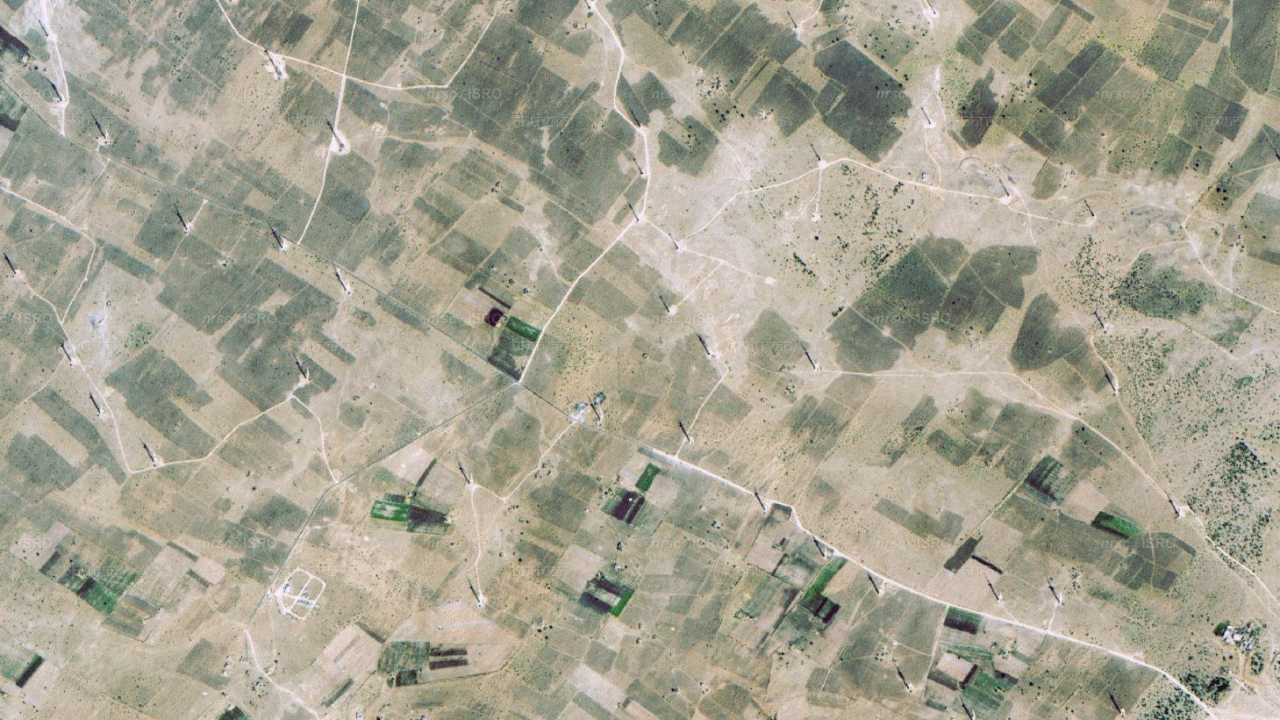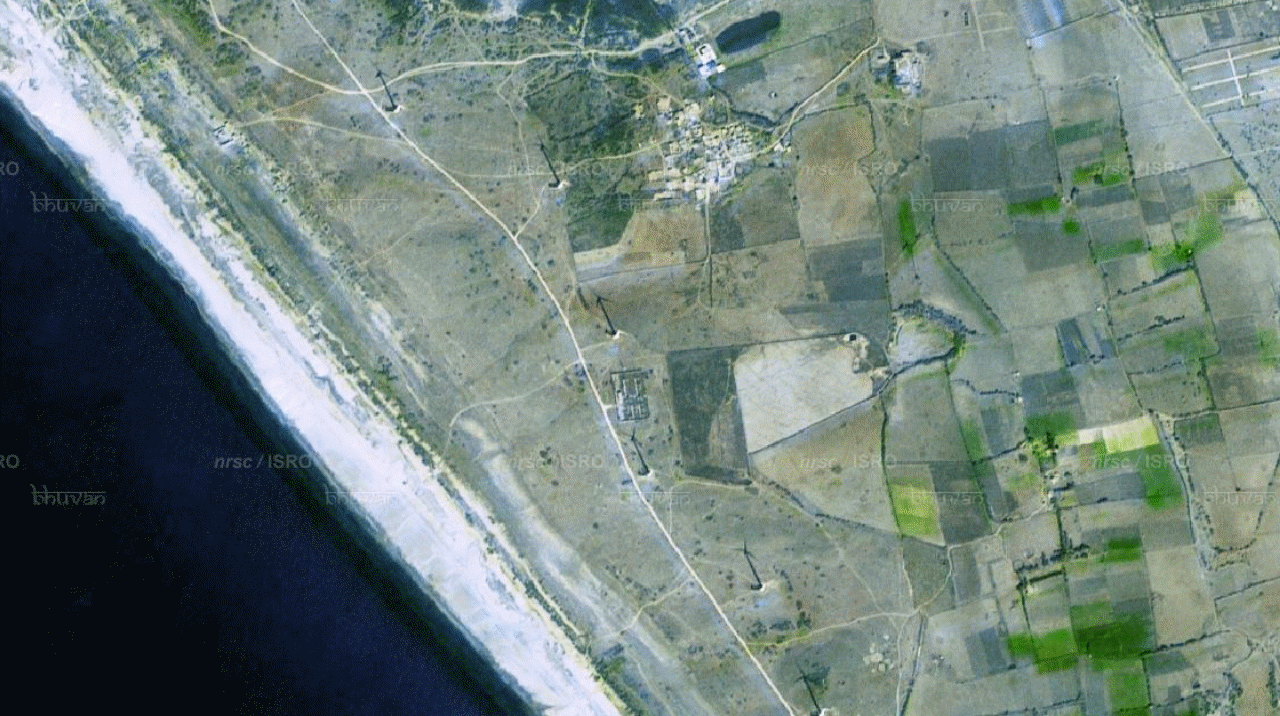
[[en]]Illustration 1: Wind Farms of Jaisalmer District, Rajasthan[[hi]]चित्र 1: जैसलमेर जिले, राजस्थान के पवन फार्म

[[en]]Illustration
2: Wind Mills at Saurashtra Coast, Gujarat[[hi]]चित्र 2: सौराष्ट्र तट, गुजरात में पवन चक्कियाँ
[[en]]Wind energy may be used to generate electricity using wind turbine. Wind energy is considered as an inexpensive and non-polluting means of electricity generation. Wind mills have moderate to low installation costs and are easy to construct. The land around wind mills may be used for other activities. The major drawback of wind energy is the significant reduction in power output during low winds. Furthermore, it may harm birds and cause noise pollution.[[hi]]पवन ऊर्जा का उपयोग पवन टरबाइन का उपयोग करके बिजली उत्पन्न करने के लिए किया जा सकता है। पवन ऊर्जा को बिजली उत्पादन का एक सस्ता और गैर-प्रदूषणकारी साधन माना जाता है। पवन चक्कियों में मध्यम से लेकर कम स्थापना लागत आती है और ये निर्माण में आसान होते हैं। पवन चक्कियों के आसपास की भूमि का उपयोग अन्य गतिविधियों के लिए किया जा सकता है। पवन ऊर्जा की बड़ी कमी कम हवाओं के दौरान बिजली उत्पादन में महत्वपूर्ण कमी है। इसके अलावा, यह पक्षियों को नुकसान पहुंचा सकता है और ध्वनि प्रदूषण का कारण बन सकता है।
[[en]]The drag caused by draught of wind, rotates the blades of turbine, which turns gears in a generator behind the blades and inside the turbine. The generator converts the kinetic energy of the rotating blades into electrical energy, which transmits the same to the grid (Maczulak 2010).[[hi]]हवा के झोंके के कारण होने वाला खिंचाव, टरबाइन की ब्लेड को घुमाता है, जो ब्लेड के पीछे जनरेटर में और टरबाइन के अंदर गियर को बदल देता है। जनरेटर घूर्णन ब्लेड की गतिज ऊर्जा को विद्युत ऊर्जा में परिवर्तित करता है, जो इसे ग्रिड को प्रसारित करता है (मैकज़ुल्क 2010)।
[[en]]Wind farms, comprising of hundreds of systematically arranged turbines, are developed along coasts or on plains, which receive steady winds in all seasons (Maczulak 2010).[[hi]]पवन फार्म, जिसमें योजनाबद्ध तरीके से व्यवस्थित सैकड़ों टरबाइन होते हैं, तटीय या मैदानी क्षेत्रों में विकसित किए जाते हैं, जहाँ सभी मौसमों में स्थिर हवाएं चलती हैं (मैकज़ुल्क 2010)।
[[en]]Types of wind turbines depending on axis of rotation (Hodge 2017): [[hi]]घूर्णन के अक्ष के आधार पर पवन टरबाइन के प्रकार (हॉज 2017):
[[en]]HAWT devices rotate in the horizontal plane. These wind turbines require a mechanism for yaw control to keep them pointed towards wind. [[hi]]एचएडब्ल्यूटी उपकरण क्षैतिज तल में घूमते हैं। इन पवन टरबाइनों को पवन की ओर रखने हेतु पार्श्ववर्तन नियंत्रण के लिए एक तंत्र की आवश्यकता होती है।
[[en]]VAWT devices rotate in the vertical plane. They don’t require yaw control mechanisms.[[hi]]वीएडब्ल्यूटी उपकरण ऊर्ध्वाधर तल में घूमते हैं। उन्हें पार्श्ववर्तन नियंत्रण तंत्र की आवश्यकता नहीं होती है।
[[en]]HAWT devices are more common than VAWTs. The most common configurations for the HAWT are the two- and three- bladed, the windmill, and the sail wing. The two- and three-bladed wind turbines can be either upwind or downwind, with upwind being the most common. (Hodge 2017) [[hi]]एचएडब्ल्यूटी उपकरण वीएडब्ल्यूटी से अधिक पाए जाते हैं। एचएडब्ल्यूटी के लिए सबसे आम विन्यास हैं- दो और तीन ब्लेड वाले, पवनचक्की, और पाल पंख। दो- और तीन-ब्लेड वाली पवन टरबाइन या तो पवन की दिशा में या पवन की विपरीत दिशा में हो सकती हैं, हालांकि पवन की दिशा वाली आमतौर पर प्रचलित है। (हॉज 2017)
[[en]]The total wind power potential in India is estimated at 302,251 MW at 100 m hub height (MOSPI 2019). The wind energy is the largest contributor to the grid-interactive renewable power installations in India, followed by solar energy. The total installed capacity of wind power plants in India is over 35.6 GW as on March 31, 2019 (MNRE 2020). Illustration 1 shows the wind farms in part of Jaisalmer district of Rajasthan. Illustration 2 shows wind mills along Saurashtra coast of Gujarat. [[hi]]भारत में 100 मीटर हब ऊंचाई पर पवन ऊर्जा की कुल क्षमता 302,251 मेगावॉट (MOSPI 2019) है। सौर ऊर्जा के बाद भारत में ग्रिड-इंटरेक्टिव नवीकरणीय बिजली प्रतिष्ठानों में पवन ऊर्जा का सबसे बड़ा योगदान है। 31 मार्च 2019 (MNRE 2020) तक भारत में पवन ऊर्जा संयंत्रों की कुल स्थापित क्षमता 35.6 गीगावॉट से अधिक है। चित्र 1 राजस्थान के जैसलमेर जिले के हिस्से में पवन फार्म दर्शा रहा है। चित्र 2 गुजरात के सौराष्ट्र तट पर पवन चक्कियाँ दर्शा रहा है।

[[en]]Illustration 1: Wind Farms of Jaisalmer District, Rajasthan[[hi]]चित्र 1: जैसलमेर जिले, राजस्थान के पवन फार्म

[[en]]Illustration
2: Wind Mills at Saurashtra Coast, Gujarat[[hi]]चित्र 2: सौराष्ट्र तट, गुजरात में पवन चक्कियाँ
[[en]]References:[[hi]]संदर्भ:
Hodge, B. K. 2017, Alternative Energy Systems and Applications, Second Edition, John Wiley & Sons, Ltd., Hoboken, NJ, USA.
Maczulak, A. 2010, Renewable Energy, Sources and Methods. Facts On File, Inc. New York.
MNRE. 2020, Ministry of New and Renewable Energy (MNRE), Available: https://mnre.gov.in/solar/solar-ongrid/, Accessed: July 22, 2020.
MOSPI. 2019, Energy Statistics 2019. New Delhi: Ministry of Statistics and Programme Implementation (MOSPI).
NITI Aayog. 2015, Report of the Expert Group on 175 GW RE by 2022. New Delhi: NITI Aayog.